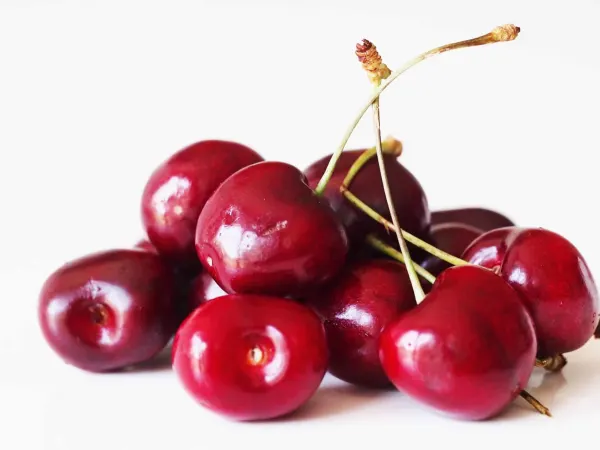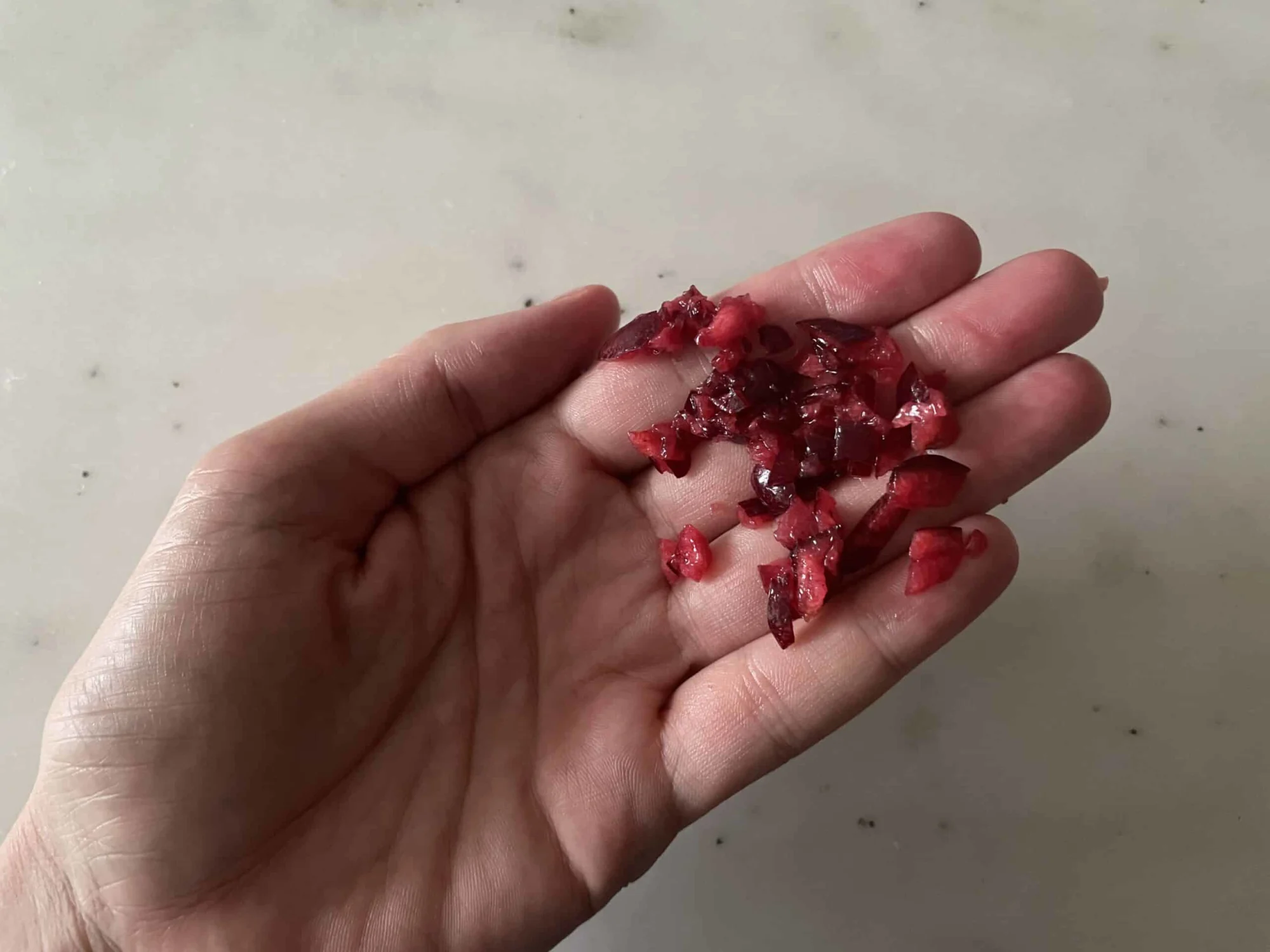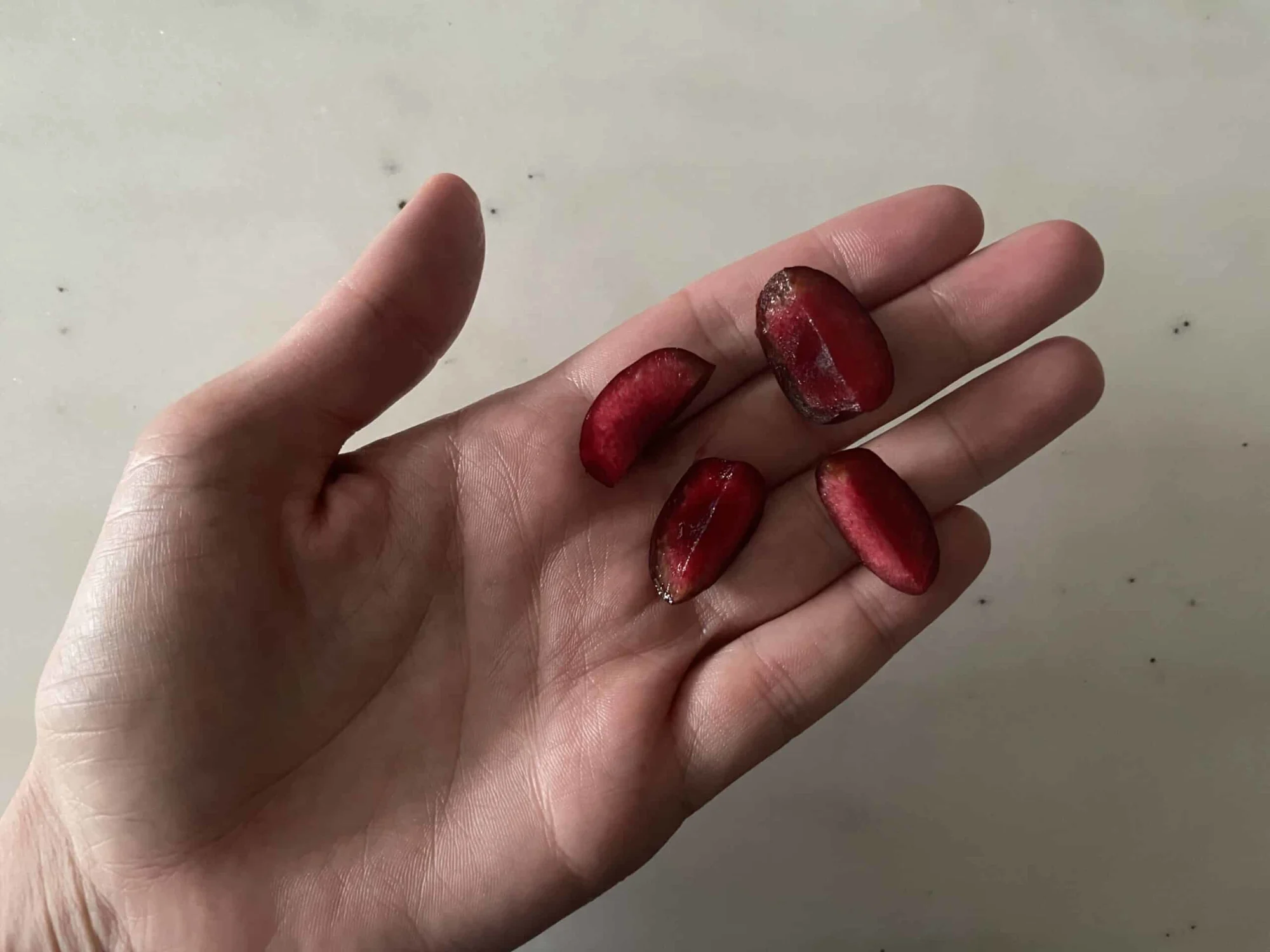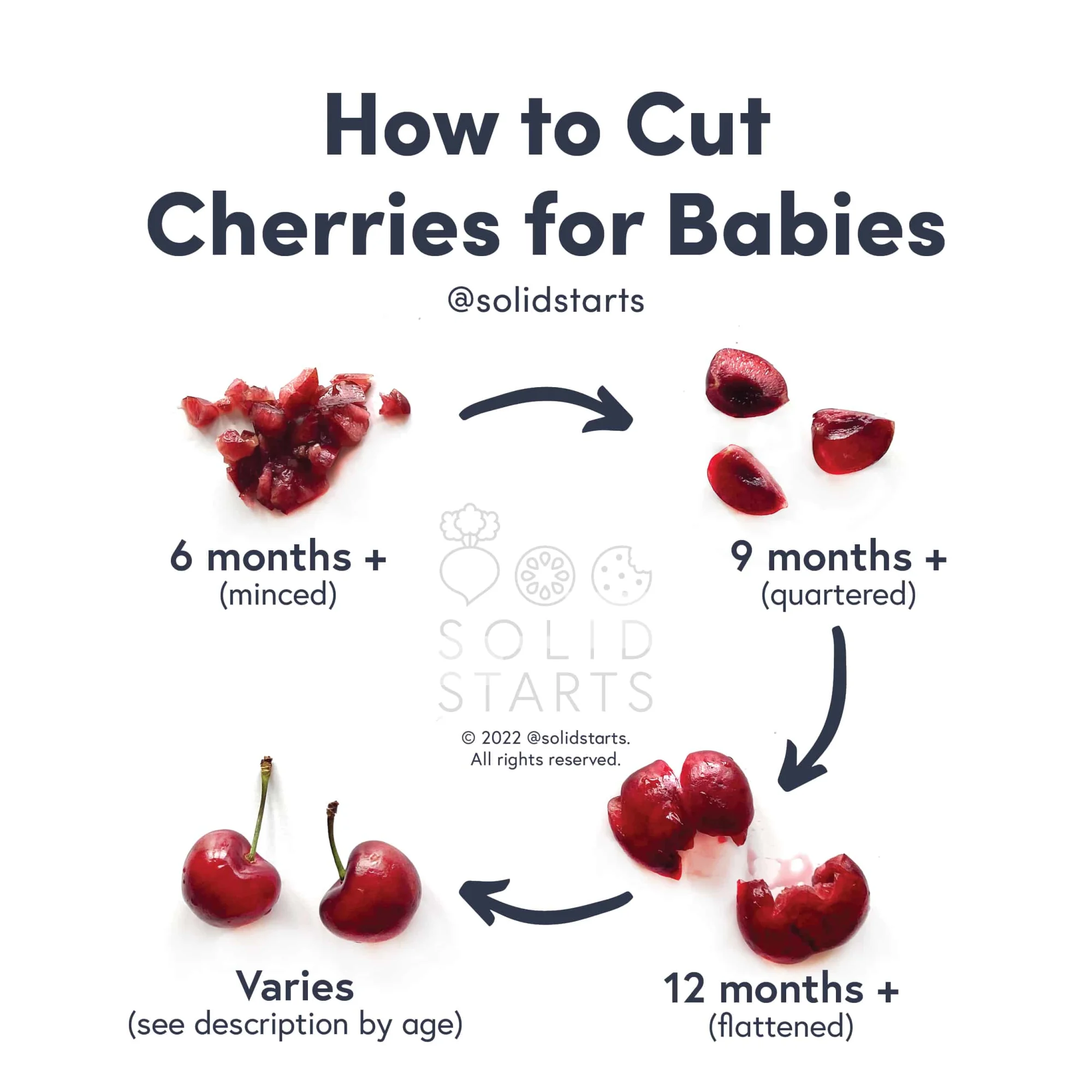Cherry
Fruit
Age Suggestion
6 months
Iron-Rich
No
Common Allergen
No

When can babies eat cherries?
Cherries can be introduced as soon as baby is ready to start solids, which is generally around 6 months of age, although you may want to wait until closer to the 9-month mark to serve them on their own. Cherries must be pitted and quartered to reduce the choking hazard, making them challenging for young babies to pick up independently. Got red cherries? Serve on bath day because the mess is real. The juice easily stains hands, faces, and almost any surface that it touches.
Warning
Cherries are a common choking hazard, so keep reading to learn more about serving this fruit safely to babies.
Where do cherries come from?
The cherry traces back to the wild fruit that originated in the fertile areas around the Black Sea. In that region, humans learned to cultivate the tastiest cherries to eat and trade with cultures in Africa, Europe, and Asia, where the plant’s blossoms came to symbolize beauty, love, and the evanescence of life. As colonization spread to the Americas, cherry orchards were established in cooler regions of the land that would become the United States, and today the fruit continues to grow in abundance in states like Oregon, home of one of the world’s most popular varieties, the ruby red Bing cherry. Behind the name of this sweet fruit is a bitter story: Bing cherries honor a Chinese immigrant who worked for 30 years on American orchards in the 19th century only to be blocked from re-entering the country by the Chinese Exclusion Act after a family visit in his homeland.
From Germany (called kirshen), to Chile (cereza), to Turkey (kiraz), there are thousands of varieties in all sorts of colors. Cherries also vary in taste; some are sweet cherries and others sour, and both types can be eaten fresh or cooked in desserts and savory dishes.
Videos
Are cherries healthy for babies?
Yes. Cherries offer loads of flavor, lots of fiber to promote healthy digestion, and small amounts of beneficial nutrients. For example, the fruit contains carotenoids that act as antioxidants and convert to vitamin A in the body to support healthy cells and vision. There’s also a bit of vitamin C, an essential nutrient to nourish cells and build a robust immune system in growing babies. Just keep in mind that cherries can cause abdominal bloating and gas as well as create a laxative effect, so take care not to overdo it.
Sweet and sour cherries share a similar nutritional profile, with a few notable differences. It’s probably no surprise to learn that sweet varieties contain more natural sugar than their sour counterparts. In contrast, sour varieties contain higher levels of vitamin C, carotenoids, polyphenols, and other powerful antioxidants that range in benefits from reduced inflammation to sleep support.
★Tip: If fresh cherries are not available, choose frozen or canned cherries packed in water or natural juices and do your best to avoid cherries in syrups, which are typically high in added sugars. Only have canned cherries in syrup? Try draining the cherries of their syrup and rinsing them before serving to remove excess sugars.
Can babies eat sour cherries?
Yes. Both sweet and sour cherries are perfectly fine foods to serve to babies, but there is a world of difference in flavor. The rule of thumb is: the darker the cherry, the deeper the flavor – no matter if the fruit is the sweet or sour variety.
Keep it simple when introducing sweet or sour cherries to young babies and feel free to offer whatever kind of cherry is available to you. There are sweet burgundy skinned Lapins with scarlet juices, ruby-red Morellos with sour tang, golden-pink Rainers with juice as bright as the noonday sun, and many more. Once a child is older, there are numerous cherry dishes from around the world to develop the palate: Hungarian sour cherry soup called meggy leves, Japanese sakurayu tea made with cherry blossoms, and delicious French clafoutis custard baked with sweet cherries, just to name a few.
★Tip: If the tangy taste of sour cherry is too intense, try stewing it with apple, fresh orange juice, or another sweet fruit instead of refined sugar, which you want to limit in the diet for babies and toddlers.
Can babies eat dried cherries?
No. Dried fruit is a choking hazard and is also a form of condensed fruit sugar. If a recipe or dish you’d like to share with baby calls for dried fruit, try rehydrating the fruit in warm water and then mincing the rehydrated fruit and folding it into the dish.
Are cherries a common choking hazard for babies?
Yes. Cherries present a choking risk because they are firm and round with a hard pit in the middle. Dried cherries also present a risk as they are challenging for babies to chew. To minimize the risk, quarter pitted cherries before serving and refrain from offering dried cherries. As always, make sure to create a safe eating environment and stay within an arm’s reach of baby during meals.
For more information on choking, visit our sections on gagging and choking and familiarize yourself with the list of common choking hazards.
Are cherries a common allergen?
No. Although serious allergic reactions to cherry have been reported, cherry is not considered to be a common food allergen. Individuals who are allergic to the pollen from birch trees or who have Oral Allergy Syndrome (also called pollen food allergy syndrome) to other foods in the Rosaceae or stone fruit family may be sensitive to cherries. Oral Allergy Syndrome typically results in short-lived itching, tingling, or burning in the mouth and is unlikely to result in a dangerous reaction. Cooking and peeling the fruit can help to minimize the reaction. However, cherries can be difficult to peel due to their small size.
As you would do when introducing any new food, start by offering a small amount for the first few servings. If there is no adverse reaction, gradually increase the amount served over future meals.
How do you prepare cherries for babies with baby-led weaning?
Every baby develops on their own timeline, and the suggestions on how to cut or prepare particular foods are generalizations for a broad audience.
6 to 9 months old:
Finely chop pitted and de-stemmed cherries to fold into soft foods like chia seed pudding, oatmeal, porridge, ricotta cheese, or yogurt. You can also mash the chopped cherries for a smoother texture. Pitted and chopped cherries can also add sweetness to savory dishes like cooked grains, mashed vegetables, or shredded meat. You can also serve the pitted and chopped cherries on their own for baby to scoop with hands but be prepared for stained hands! If you’d like to serve dried cherries, rehydrate the fruit in hot water for 15 minutes, then purée the fruit and fold a small amount (a small spoonful) into a scoopable food.
9 to 12 months old:
Serve quartered cherries that have been pitted and de-stemmed. If baby is having a hard time picking up the cherry quarters, you can try offering whole, pitted cherries that have been smashed into flat discs. If you’d like to continue with minced cherries or a small amount of rehydrated cherries that have been pureed, minced, and mixed into a scoopable food, by all means do so.
12 to 24 months old:
If you feel your toddler is ready, try offering whole, pitted, de-stemmed cherries that have been smashed into flat discs. If you are finding your child is spitting a lot of the fruit out, try cutting the discs in half to make them smaller. Closer to 18 months, you can also try serving bite-sized pieces of dried cherries (pit removed) if you feel the child has developed the biting, tearing, chewing, and swallowing skills needed to eat dried fruit. Dried fruit is a choking hazard, so trust your gut and wait to serve dried cherries until you feel your child is ready.
36 months and up:
If your child is taking accurate sized bites, not stuffing their mouth with food and able to follow instructions, they may be ready to learn how to work with an entire, pitted cherry. While whole cherries are a choking hazard, it is our professional opinion that there are enormous benefits in teaching toddlers to take bites from challenging foods and how to safely eat them. If you feel your child is ready and you’re okay taking the risk, consider serving a whole cherry, first modeling how to take bites from the whole cherry yourself. Bite into the fruit, tearing off one half. Say, “My teeth hit the hard pit.” Turn the fruit around to show the pit to your toddler. Tap it and explain, “Look, there is a hard pit in here.” Then, pull the pit out and show it to your toddler, saying “We don’t eat this part.” Dramatically toss the pit into the trash. Offer a whole cherry to your toddler and say, “you try.” You can try to hold on to the fruit while they take their first bite, but know they may get the whole fruit in their mouth anyway.
If your toddler inadvertently puts a pit in their mouth, step one: do not panic. Remember that a pit can be safely swallowed whole, or may produce a strong enough gag reflex to move it forward and out of the mouth. Kneel next to your toddler and demonstrate sticking your tongue out and say: “Spit that out please.” Put your hand under their chin while you demonstrate. If needed, put a pit in your own mouth, show it on your tongue, then demonstrate spitting it into your own hand.


How to prepare cherries for babies 6 months+
How to prepare cherries for babies 9 months+
Check out our 50 Breakfasts for Babies & Toddlers for some recipe ideas to make your mornings just a bit easier.
Our Team
Written by
Expert Tips Delivered to Your Inbox
Sign up for weekly tips, recipes and more!
Copyright © 2024 • Solid Starts Inc








